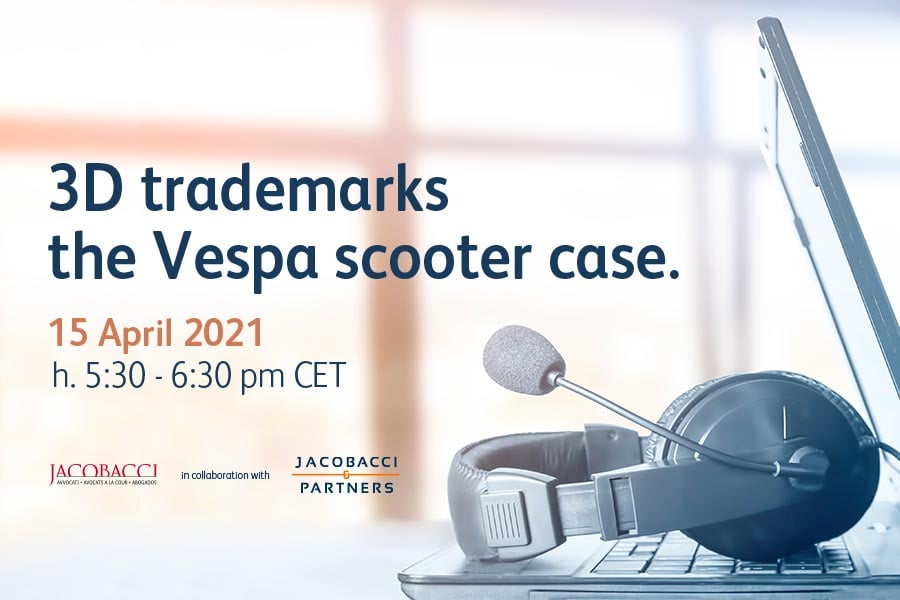Speakers:
- Barbara La Tella - Studio Legale Jacobacci & Associati
- Elena Monte - Jacobacci & Partners
Language: English
Description: The Vespa is an icon of Italian history and culture: how can its shape be protected from imitation?
Italian and European regulations offer various means of protection, such as the three-dimensional trademark and copyright. These protective measures can be combined and Piaggio S.p.A. has taken advantage of both, in Italy and in Europe, obtaining exclusive rights and, when necessary, using the copyright and trademark against imitators of the scooter's shape.
Piaggio's choice of protection has already successfully passed the examination of the Turin Court and Court of Appeal, both of which were called upon to investigate the validity of the three-dimensional trademark and the enforceability of copyright, further to a trademark nullity action filed by a giant Chinese scooter manufacturer; the last stage of proceedings before the Supreme Court is currently pending.
At the same time, the shape of the Vespa has also been examined by the EUIPO, where Piaggio obtained registration as a three-dimensional trademark, which was also confirmed following an action for invalidity brought by the same Chinese group.
The purpose of the seminar is to illustrate the main aspects of the two types of protection, starting with the Vespa case, as well as how these aspects are interpreted and applied at European and national level.
Barbara La Tella, Jacobacci & Associati
This case was very very interesting because involving a leader producer and marketer of motorcycles, Piaggio, and a Chinese group who is a leader on a worldwide basis, producing and marketing motorcycles, like Piaggio.
This dispute was very very aggressive because the Chinese group reacted quite hard to the activity put in place by Piaggio to protect its Vespa icon motorcycles.
The dispute commenced in the ambit of an international fair where Piaggio enforced two three-dimensional trademarks; they are one Italian three-dimensional trademark and a Community three-dimensional trademark, both protecting the Vespa shape, exclusively the Vespa shape, because they are three-dimensional trademarks.
On the left side, you can appreciate some views that constitute subject matter of the registration and on the ride side, you can see the icon Vespa LX, which includes all the views that you can appreciate on the left side.
The Vespa LX can be regarded as the model which better embodies the features we are talking about.
These three models are the models which seriously concerned Piaggio, when it saw them at the international fair I was talking about before.
They are the Cityzen model, the Ves model and the Revival model.
These three models were discovered by Piaggio at EICMA Trade Fair in November 2013.
To be precise, Piaggio is a regular attendee of the EICAM Fair since this is an international fair for motorcycles which we can say it’s the most important trade fair for motorcycles, merchandising, spare parts and so on.
So this is a great opportunity for producers - for motorcycles’ producers – to present their new models but also to check what the competitors are going to promote into the market.
In this specific section of the EICMA Fair in November 2013, Piaggio discovered the three models, i.e. the Cityzen, the Revival and the Ves.
Since during a fair it is forbidden by Italian Law to foresee civil seizures, you can only pursue prescriptions if you want to remove counterfeit – allegedly counterfeit – from the stands of competitors, you have to exploit the criminal step and, in particular, the owner of IP rights is called to file a complaint before the competent Fiscal Police which, considered the importance of the fair, has a physical office within the premises of the fair.
This is what Piaggio did in that occasion: filing a complaint and enforcing both the Italian and the EU three-dimensional trademarks.
There was infringement in Piaggio’s view, so they complained claim infringement according to Criminal Law.
Further to the seizure at the EICMA, since the products were in the end seized and removed from ZNEN’s stands, obviously ZNEN was not happy at all for this initiative; so in 2014, immediately after, it filed a civil action against Piaggio claiming a declaration of non-infringement of Piaggio’s three-dimensional trademarks and a declaration of invalidity of Piaggio’s Italian three-dimensional trademarks.
Obviously, the Italian authority is not competent for invalidity of a Community trademark, so that ZNEN was then obliged to act before EUIPO to the same purposes, but we will see that on a later stage.
ZNEN’s arguments were the following:
- with regard to infringement, it argued that there was no similarity between ZNEN and Piaggio’s models;
- that the customer involved in the purchase is always a prudent customer who is able to distinguish the shapes and, in particular, who focuses his attention on the verbal mark not on the shape.
Moreover, they sustained the so-called “crowded market principle”: the scooter market is a crowded market and there are so many motorcycles in their view presenting the same characteristics, that the Piaggio’s scooter could not be considered as distinctive.
As we said, ZNEN attacked also the validity of the trademark, arguing that it was not new because the trademark in their view was anticipated by ZNEN’s models.
It has no any distinctive character because embodies basic shape and features, typical of scooters.
Moreover, during the years, that shape in ZNEN’s view has become vulgarized.
The standard shape of the scooter, moreover, was also dictated by a technical functional point of view and was given a substantial value to the product, which are issues provided by our Italian Procedural Code but also by the European Regulation.
Moreover, ZNEN sustained that the three-dimensional trademark filed by Piaggio was affected by bad faith.
Again, because as for the lack of novelty, it was anticipated by ZNEN’s models and when Piaggio filed its trademark, it was aware about these models.
So it filed its three-dimensional trademarks in bad faith.
These were the main arguments put forward by ZNEN.
Piaggio filed its defence not only requesting the Court of Turin the full dismissal of the other party’s claims but also presenting its own counterclaims.
Precisely, it argued and claimed that there was infringement of its trademarks made by the three ZNEN’s models.
Moreover, and this argument was absolutely important for the case together with the 3D mark, Piaggio sustained and proved that this was a case also of copyright infringement because Vespa was protected by copyright.
Moreover, and way of conclusion, as it always happens in case of trademark infringement, Piaggio sustained that it was also a case of unfair competition because of confusion, misappropriation of merit and commercial misconduct.
What happened during these proceedings?
These proceedings in the end proved to be absolutely successful for Piaggio.
It was handled by the President of the IP Chamber, Mrs. Vitrò, and the panel of three Judges in charge of the case, decided that the 3D mark for the Vespa shape was absolutely valid and declared one out of the three models involved in the proceedings - the Ves model - was infringing the trademark, the copyright and was an hypothesis of unfair competition.
During the proceedings, an important role was performed by the CTE appointed by the Judge.
Since there were many technical issues to be investigated and set, the Judge decided to be assisted by an engineer – a mechanical engineer – and his assistance was very important because he explored the validity and infringement claims from a technical point of view but, while examining the documents produced by Piaggio, he also added to the arguments provided by Piaggio, something new which was of great help to the defence of Piaggio.
So the Court of Turin decided that Piaggio’s trademark was absolutely valid:
- because it was new; the mark was in fact enjoying the priority of a previous model: the Vespa LX, dating back to 2005 whilst the ZNEN’s models were dating back to 2010.
But this is not the only one reason for the novelty of the trademark: we have also to consider that the Vespa shape was on the Italian market from 1946 and during the years it had acquired a great and eradicated fame into the Italian market. So, Piaggio could enjoy prior use.
Finally, and this is a very interesting point: the point where the CTE gave his specific assistance to the Judge:
- the distinctiveness of the mark because, as the Court of Turin said, the shape of Vespa was embodying from 1945 when Corradino D’Ascanio created the Vespa shape, some essential features which remained absolutely the same during the years despite restyling, adjournments of the motorcycle to meet the customer’s needs but those four characteristics have always remained the same.
First of all, the arrow-shaped front shield profile that, in the feature, you can appreciate in green.
The inverted Ω between the saddle and the front shield, which is presented in red.
The X between the lower edge of the saddle and the rear fairing, that you can see in blue.
Finally, and this is the great support arising out from the work of the CTE, the fourth characteristic which is the cheek of the rear bodywork shaped like an elongated teardrop.
I can say that during the proceedings Piaggio presented some documents to demonstrate that the first three characteristics were present in the shape from 1945 up to 2013 when the 3D mark was filed.
The CTE, while examining such documents from the beginning until the registration of the mark, understood that there was a fourth characteristic: the last one we have just seen.
The arrow-shaped front shield profile is present from 1946 till 2013. This is very important because the Vespa was subject to many restyling in the years but this characteristic was always there.
We can find the inverted Ω in red and, finally, the third characteristic represented in red and is present, again, from the beginning up to the registration of the mark.
The Court embodied completed the defence of this distinctive character made by Piaggio by affirming – and this is literal quotation from the sentence – that “(…) It is therefore considered that the distinctive character of Piaggio’s registered trademark derives from the constant presence, in Vespa scooters, of four individualising features, since their origin (1945). These four characteristics identify the overall shape of the Vespa covered by the registered three-dimensional trademark, and constitute its “heart”, clearly visible (even by the mere examination of the registered drawings) and original, and distinguish it from other scooters into the market, determining its traceability to the manufacturer Piaggio”.
So, the distinctive character of the shape was fully recognized. In the same, the validity of Piaggio’s trademark was recognized because all the other claims and arguments brought by ZNEN were absolutely dismissed.
Vespa shape could be not regarded as a vulgarized shape because the proofs provided by ZNEN to demonstrate that there were many many models into the Italian market reproducing the characteristics of Vespa, were not successful. They were not enough.
In particular ZNEN pointed all its efforts on the Lambretta model but the Lambretta model was no longer into the Italian market from years, so it was not able to vulgarize a trademark like the Vespa shape.
Moreover, the new version of the Lambretta was launched much time after the trademark registration of the shape.
Vespa was very popular in Italy and the Court recognized the results of the demoscopic survey pursued, carried out, by Piaggio. This survey provided really great results because customers who were interviewed during the survey, not only recognized the Vespa from the shape without obviously any verbal trademark, an indication of the shape of the Vespa, but also as a shape coming from Piaggio.
And we can say that the percentages of this survey were from 80% to 90% of full recognizement. So a very great result.
It was really a well-known mark into the mark.
Bad faith excluded!
In fact, as we said before, ZNEN sustained that its models dated back to 2010 so they were anticipating the 3D registration which was dated 2013 but they did not consider that the trademark of Piaggio was into the Italian market since 1946 and so any bad faith has to be excluded.
Thanks to the support given by the CTE, the Court confirmed the Piaggio’s defence also with regard to all the other hypothesis of invalidity; in particular, the Court concluded that the Vespa shape was not imposed by the purpose of being a motorcycle. It was not the only possible shape: there were in fact into the Italian market many other scooters not having all the Vespa features. Maybe one, two or three, but not the four distinctive characteristics.
Moreover, the shape of Vespa was not necessary fundamental to obtain a technical result. The same technical result could be achieved without the reproduction of the arrow, of the Ω, or of the other characteristics.
Finally, and this was a very important point, because this issue is always very debated in Courts when it is brought to their attention: the shape of Vespa was not considered as giving a substantial value to the product.
It is an objective conclusion that when a customer purchases a Vespa, he is certainly motivated by the design, by the aesthetic, but this is not the only element that drives the purchase.
The customer, who is a prudent customer and ZNEN properly underlined, also considers the price of the product, the fuel consumption, technical characteristics and so on.
So, the Court excluded also this hypothesis of invalidity.
With regard to infringement the Court, on the basis of the things we have illustrated today, decided that only one model out of three was infringing the trademark, the copyright and was a case of unfair completion.
We are talking about the Ves model.
The Ves model includes in its shape all the four characteristics: that’s the reason why the Court concluded for infringement.
We have to add – but it is quite blatant – that there is also a serious bad faith in ZNEN which decided to use not only the four characteristics we have been talking about till now, but also some other elements which were not distinctive and fundamental, like the mirrors, the seat profile and so on and moreover, a very serious indication of bad faith, the use of the name VES, which is a synthesis of the name VESPA.
So, if a confusion can be regarded as existing already because of the copy of the shape, this was increased by the use, the exploitation by ZNEN, of other characters and of the name VES to distinguish its motorcycle.
So, the conclusion was infringement and unfair competition.
This case is very interesting because it represents a combination of protection of a shape, because protected thanks to the 3D mark, but also thanks to copyright.
The copyright is always a very debated argument and protection when we talk about industrial design and, in this case, we also assisted to this debate because ZNEN very aggressively sustained that Vespa was simply a piece of industrial design. Thus, not being capable to benefit and enjoy a protection from copyright.
It is true.
The Vespa was born as a piece of industrial design but, after 1945, it received a lot of accolades over the years: we can remember that it is present and MOMA; it was promoted in many publications, exhibitions and so on. So that, today, we can say without any doubts that Vespa represents a symbol of the Italian culture and history.
So, the Court could only recognize that this was the truth.
The shape of the Vespa undoubtedly began as a piece of industrial design. This was a pacific circumstance. However, over decades it has acquired so much appreciation from the artistic and not merely industrial world which greatly celebrated its creative and artistic qualities, that it has become an icon symbol of Italian costume and artistic design.
These multiple and exceptional recognitions by numerous and important cultural institutions, which include the Vespa among the most relevant expressions of design, confirm its creative character and artistic value.
We are specifically underlying these pieces, these portions of the decision because the main defence of ZNEN with regard to copyright was that Vespa was born as an industrial design and it was not a piece of art at its origin. So, it could not enjoy of a copyright protection.
The Court responded to this attack by saying that copyright is not considered to protect only an industrial design which in the author’s mind should have had a creative character from the aspect and was also conceived for artistic purposes.
A work of industrial design may come into being as a mere external technical form of an industrial medium and subsequently acquired through the collective recognition by the market and artistic circle, an artistic value which goes beyond its original merely technical and functional value.
It’s clear that, when Corradino D’Ascanio in 1945 created the Vespa, his intention was to put into the Italian market a motorcycle.
He was not intended at all to produce a piece of art. It was an industrial design but thanks to what happened in the following years, today and even before today, Vespa is a piece of art and the Court recognized the copyright.
Obviously, ZNEN was not happy at all of this result as it was not happy of what happened after the EICM fair. So, he decided to appeal before the Court of Appeal of Turin but it was not fortunate at all because the Court of Appeal not only confirmed the decision of first instance, but in the grounds it greatly deepened the protection of the Vespa shape brought on the 3D trademark and on copyright.
So, the appeal was entirely dismissed.
As you can imagine, ZNEN was again not happy at all, so we are now before the Supreme Court; we are awaiting the first hearing to discuss the case, but we are confident that there are good chances that also the Supreme Court will confirm the conclusions of the Tribunal of Turin and of the Court of Appeal because the reasoning in both decisions are so well motivated and the defences of Piaggio so well welcomed by both instances of the Court that it could be very very difficult to ZNEN to obtain a favourable result.
We are waiting so that the case is still ongoing.
Elena Monte, Jacobacci & Partners
ZNEN was not happy at all with what happened in Italy and it was not satisfied neither by brought an action before the Italian Courts to obtain the invalidity of the Italian three-dimensional trademark and so it filed an action also against the three-dimensional trademark that Piaggio registered in 2013 before the EUIPO.
The trademark, as you can see, corresponds to the Italian trademark registration that we have seen before.
Here again the grounds for the action are more or less similar to the ones brought before the Italian Courts.
In particular, ZNEN claimed a relative ground based on the absence of novelty of the trademark for being anticipated by its design for the Revival model, which was obtained in 2010.
Then, it brought for absolute grounds. First of all, the lack of distinctive character; then, the shape to be necessary to obtain a technical result. The shape gives a substantial value to the product and, lastly, the bad faith at the time of the filing of the trademark by Piaggio.
Let’s see a little bit more in depth what happened during this action but, first of all, I am pleased to let you know that we recently received the decision, last December, after six years of proceedings, which rejected entirely the action brought by ZNEN confirming the validity of the three-dimensional European Union trademark.
Let’s see the grounds with a little bit more in specific.
The first ground was the absence of novelty of the trademark for being anticipated by the model Revival of ZNEN.
This model was granted in 2010, while the trademark was filed in 2013.
The trademark of Piaggio corresponds to the shape of the Vespa LX, which is a model that was launched in the market in 2005, so five years before the design registered by ZNEN.
So thinking a way to neutralize this relative ground, Piaggio decided to file a separate action trying to obtain the invalidation of such Community design.
This was a manner to neutralize this ground, because on the one hand it could obtain the invalidation of the Community design; on the other hand, in the case the Community design were to be declared as valid, then we were going to expect a similar conclusion also during the action against the three-dimensional trademark.
And, at the end, this what happened. Piaggio, within the action against the design, succeeded in the first instance.
Then, the decision was appealed and then it won the action in the appeal and then again before the Court of Justice of the European Union but what was important for Piaggio was the reason of the rejection of its action against the design.
And the reason was the fact that the trademark produced a different overall impression with respect to the Community design and the EUIPO, in its decision, simply recalled the decision of the Court of Justice stating that the shapes under comparison are exactly the same, so it could not reach a different conclusion.
And therefore the relative ground was rejected.
These are the two signs under comparison: the Piaggio’s trademark and the ZNEN’s design as registered.
With reference to the absolute grounds, first of all the EUIPO recalled that a trademark, which has been already considered before its registration in its main characteristics, has a presumption of validity and the Cancellation Division cannot be required to carry out a fresh examination on its own motion of the relevant facts which may lead to apply absolute grounds for refusal.
So it is on the part of the applicant of the invalidity, who wants the trademark to be declared invalid, to submit the arguments, facts and evidence that could call the validity into question.
Going to the lack of distinctive character, we can already see how the EUIPO applied this principle because it simply stated that the applicant for the invalidity failed to demonstrate the absence of distinctive character of the shape of the Vespa and particularly stated the claim that the contested EUTM consists of a common shape of a scooter that is widespread on the market during the relevant period is not supported by any relevant evidence.
So, just a generic argument that the scooter reproduces a very common shape is not sufficient to demonstrate the absence of distinctive character.
Moreover, we have to know that the trademark was granted having acquired a secondary meaning.
So, this was also an argument on the basis of which ZNEN invoked the absence of distinctive character of the mark.
But once again, the EUIPO rejected also this argumentation and, in particular, stated that a user who consults the register cannot know whether the proprietor claimed acquired distinctiveness in response to a refusal and, in such a case, what was the content of the refusal.
And then it follows that the existence of a refusal cannot be regarded as a ground on which to substantiate the lack of distinctive character of the contested EUTM.
And the proof of the lack of distinctive character must be provided by the applicant for the invalidation and it is not simply because a trademark has been granted by secondary meaning.
Let’s see the main points of this decision that have dealt with the shape necessary to obtain a technical result of a shape that gives a substantial value to the sign.
Again, these absolute grounds were claimed by ZNEN and were completely rejected.
With reference to the technical function of the shape, the EUIPO stated that the applicant has neither identified the essential features of the sign, nor indicated the technical function performed by those features.
The EUIPO stated in particular that, in order to evaluate whether the trademark has to be refused or invalidated for being a shape necessary to obtain a technical result, it stated that it is necessary to identify all the essential features of a trademark and not just one or few of them. And then it must be conducted a proof of these essential features for being responding to technical function.
If such a proof is not given, then we cannot concluded that the shape has such a technical function.
ZNEN in particular pointed out one of these essential features but did not recognize all the essential features of the trademark and, with reference to this only one feature, he just said that it suggested an idea of technical function.
The Examiners stated that the applicant merely refer to a single feature defined as essential which, according to the applicant, consisted of the arrow-shaped front shield which suggests the idea of speed.
May I remember the front shied as it has an arrow shape as Piaggio itself highlighted during the process of registering the trademark and also of defending the same, the other party tried to leverage on this kind of technical function of the arrow-shaped front shield, but it also proved its technical function.
The argument that a certain shape feature evokes an idea in the consumer does not show how such feature would fulfil the alleged technical function.
With reference to substantial value that the shape gives to the product, once again, the EUIPO concluded that the applicant for the invalidation failed to demonstrate such claim.
In particular, it stated that, although the shape in question may be regarded as attractive by part of the relevant public, in principle, it is considered that when purchasing the goods consumer will consider not only the aesthetic characteristic of the shape of the product but also other characteristics such as, for example, reliability and technical performance.
We can see how the European conclusion in this case was exactly the same that we have seen by the Italian Judges. It brought the Examiners and, in both cases they highlighted the aesthetic value of the shape of the Vespa, which is indeed attractive for the consumers and its aesthetic value certainly contributed in the fame of the shape of the Vespa and its success on the market, but this is not the drive for the consumers who are going to buy a scooter, because there are other characteristics which are also very important such as reliability and technical performance.
The EUIPO also considered this situation in a more general scenario stating that the fact that the shape – or other features – may be pleasing or attractive, is not sufficient to exclude the trademark for registration because, if that were the case, it would be practically impossible to imagine any trademark for a shape or other characteristics since in modern business practice there is no product of industrial interest not undergoing study, research and industrial design before being launched on the market.
This is an important point of this decision, as we have seen during the last year; quite a change in the EUIPO practice with reference to three-dimensional trademark: for example, we all know the very famous case regarding the TRIPP TRAPP kid chair and other famous trademarks – other famous shapes – which were not considered as being devoid of a protection as three-dimensional trademarks for being shapes that give substantial value the products.
So this was a very important point and the fact that the EUIPO concluded that a shape – an attractive shape – does not mean that the shape cannot be registered as a trademark is a very important point for all operators in the field of industrial design.
Moreover, the EUIPO decided to clarify another very important point with reference to the coexistence of various legal protection titles.
We all know that the European Union Guide differently approaches, most of all, with reference to copyright granted to products of industrial designs.
The EUIPO stated that “(…) Although the objective of the ground for refusal is to prevent the exclusive and permanent right conferred by a trademark from being used to perpetuate, without any limitation in time, other rights which the EU legislature intended to subject to a validity term, such an objective does not mean that EU law on intellectual property does not prevent the coexistence of various legal protection titles”.
So now we have a very clear example of how to protect a shape under different titles and Vespa is such an example.
It is protected as a three-dimensional trademark and it’s coming in enjoying protection for registered design and also of industrial design protected under copyright.
Finally, the other party claimed bad faith at the time of the application by Piaggio.
This ground was based mainly on the fact that Piaggio produced documentation regarding not only the model of Vespa LX, to which the three-dimensional corresponds, but also regarding previous models.
There are some characteristics/features of the Vespa that are present in the models since its first launch on the market and remained in all models that were launched during more than seventy years.
And so Piaggio decided to trace the story of the Vespa by illustrating which are those characteristics which are to be considered distinctive, as both the Italian and EUIPO then considered, by highlighting the story of the Vespa through its several models.
And the other party considered this behaviour as being bad faith because on its story Piaggio tried to focus the attention of the Examiners on the different models and not only on the model corresponding to the trademark as registered.
But, once again, the EUIPO rejected such claim by ZNEN and, in particular, stated that “(..) In the assessment of bad faith, what matters are the subjective intentions of the proprietor at the time of filing the contested EUTM, which translate into actions that can be put in relation to a conduct that departs from accepted principles of ethical behaviour or commercial and professional practices of fairness”.
So, as stated before, the action was rejected the validity of the trademark was confirmed but we have not to waste a long time to see that ZNEN, once again, appealed this decision last February.
So, the case is again still ongoing and we hope to be able to let you know what happened during the appeal in the next months or – we hope not – years.
Q&A
I’ve read in the chat that a person is interested in understanding why during the EICMA Fair we enforced simply the trademarks and not the copyright.
We must say that, when you present a complaint before the Criminal Officers, which is then brought before the Criminal Court, who presents the complaint, must be owner of certified and registered IP titles.
Unfortunately, copyright has not these characteristics in Italy.
So, it cannot be enforced before a Criminal Court and, in particular, during a fair, because there you can only enforce trademarks, patents, designs, models, not copyright.
Since the measures that the officers, the Criminal Officers, and in the end a Criminal Court takes against the alleged infringers, are so serious, they need that the claims are founded on registered IP rights. So that during the fairs, you can only act through the Criminal Court and through IP registered rights.
You cannot benefit from civil seizures and you can only benefit from civil description, because the fairs are regarded as a sort of protected area where competitors must be free to present their products and, if there is any conflict that can be postponed, it has to be postponed.
But the case there is a so serious illegitimate conduct, that amounts to a criminal conduct, then it has to be stopped immediately, not on the basis of copyright.
I must say that, recently, in the last years, some Customs and some Fiscal Police Offices accepted complaints based on copyright if you are able to produce final decisions recognizing copyright with regard to the shape you are enforcing in that case, but they are still few decisions.
So, I would not advise to enforce copyright during a fair or before the Criminal Court in general.
So, this is my response to this question.
There is a question asking me more information concerning the evidences that we have used to demonstrate the distinctive character of the shape of the Vespa.
Okay.
We have done two different things.
During the registration process, when we claimed the acquired distinctiveness of the trademark, we presented a very complex and wide set of evidences, but they were all indirect evidences: we did not perform a market survey.
This is because we could base our claim on a lot of documentation, not only the story of the Vespa and/or the prices gained by the Vespa - or the awards - on the appearance of the Vespa in many work of arts, as also Barbara stated.
But we had the possibility to contact all the agencies around the different countries in the European Union and obtaining the information concerning the data of the homologation of scooters.
So we had information concerning the market share of the Vespa comparing the scooter with these competitors and, specifically, in the segment referred to classic scooters.
And obtaining such information, we noted that Piaggio had in some countries a kind of monopoly and in other countries a very leading position – the first position – in the market; so through these information that were collected for all the EU Member States, we could demonstrate not only that consumers can be aware of the shape of the Vespa but they know it properly because they are really the consumers of the Vespa scooter because they buy the Vespa scooter most of all, on top of all.
So this kind of set of documentation was considered sufficient by the EUIPO and also by the Italian PTO to grant the registrations.
During the action, on the other hand, we decided to perform some market survey because we want to strengthen our position and to demonstrate through a very important set of evidences that the shape of the Vespa is indeed recognized by the public for being a source of origin.
So, we conducted a market survey selecting twelve Member States of the EU and, particularly, countries which could be very significant on the one hand for being the most important countries for scooter market but also for their dimension.
So, for example, we did not perform a market search in the North of Europe countries as they do not have a long tradition of being users of scooters.
And, at the end, we resulted with twelve market surveys which ended in very astounding results because we obtained a knowledge of the shape of the scooter for being a Vespa - but not only for being a Vespa - for being a product of Piaggio with a percentage of at least 63% of the interviewed public raising up to 90% in countries such Italy, of course.
So, it was very important for us because it did confirm the results that we already obtained by demonstrating the leadership on the market of the Vespa scooter.





